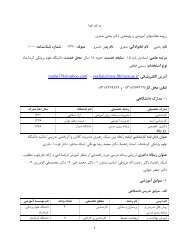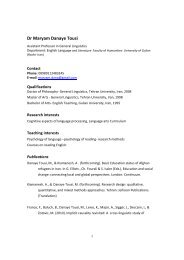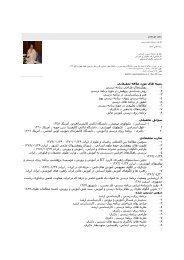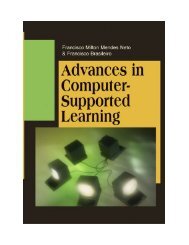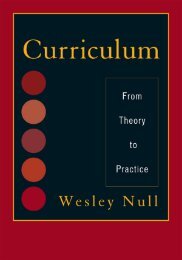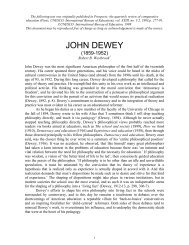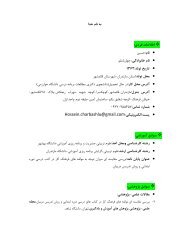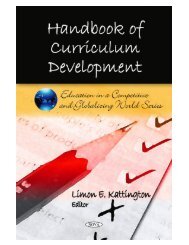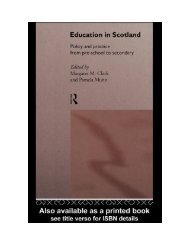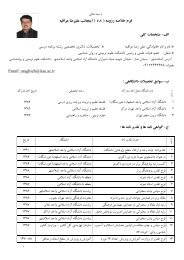DIFFERENTIATION AND EQUAL OPPORTUNITIES 19Jackson (1964) argued that we create types of children <strong>by</strong> believing thatthere are types and hence treating them differently. The characteristics of a cstream child come into being through the existence of c streams, not because ofcommon inherent characteristics of children allocated to those categories. Sincemovement between streams was rare, the process of sorting children <strong>by</strong> abilitymeant that decisions that would have irrevocable consequences for childrenslong-term development and life-chances were being made within a year or twoof starting school. The expectations created <strong>by</strong> the labels, once applied, seemedto become self-fulfilling. Procedures that were intended to promote a fairerdistribution of educational opportunities were actually reproducing existingpatterns of inequality (Coard 1971; Rist 1971).Hargreaves (1967) drew attention to the effects of selective grouping uponpupils in a secondary modern school. He showed how the stream to which apupil was allocated affected their attitudes and expectations and those of teacherstowards them. Gradually a polarising effect occurred, with pupils allocated to thelower streams becoming increasingly oppositional and resistant, while thoseallocated to the top streams remained closely identified with the aims and valuesof the school. Lacey (1970) found similar processes operating in a grammarschool. He used the term polarisation to describe the social processes set inmotion <strong>by</strong>, and bound up with, institutional processes of differentiation. LikeHargreaves, he traced how groups formed a social identity (or subculture), withits own norms and values, that reflected their position in the status hierarchy,leading to the progressive alienation from the schools aims and values of groupsassigned to low status positions.I believe that most teachers will have had at least some experience to call onwhich corroborates the findings of this research: the damage which can beunintentionally done to learners confidence, self-image, attitudes andcommitment to learning through the impact of labels and more subtle messagesconveyed to them through differential treatment. In my own case, on teachingpractice in a grammar school, I remember being greeted <strong>by</strong> pupils in the secondability set out of four with the information that they were useless and I wouldbe better advised to request to teach the top set. I remember, in my own grammarschool education, how polarisation began to occur, in attitudes and behaviour, asclasses went up the school, with those selected to continue with Latin becomingthe elite, and those taking cookery instead becoming disillusioned andoccasionally even rebellious as a result of their perceived second-class status. Iremember, too, during my teaching career, salutary encounters with sinkgroups of disaffected youngsters (groups created with the best of intentions tocater for those perceived to be in need of extra English) who had long given upany hope of gaining any personal sense of achievement and satisfaction fromschool learning.This is not to deny that opting for mixed-ability or undifferentiatedapproaches to grouping can create its own problems. Research pointed to similarprocesses operating within comprehensive schools, and even where classes had
20 WHAT IS DIFFERENTIATION?been organised on an unstreamed or mixed-ability basis. The problem, it beganto emerge, was more to do with particular ways of thinking about learners, andresponding to perceived differences, rather than specifically with how pupilswere grouped. Ball (1981, 1986) studied the shift from a system of banding tomixed-ability grouping in one comprehensive school, and found that theprocesses and effects were even more marked in mixed-ability settings. Heconcluded that this was, paradoxically, because of teachers heightenedawareness of differences in this situation, and more concerted effort to makeprovision to accommodate them. This was, as we have seen, precisely what HMIwere recommending as good practice in responding to diversity within ateaching group.FROM CATEGORIES OF ABILITY TO INDIVIDUALNEEDSNevertheless, a significant change has certainly taken place in the terms in whichdifferentiation is now formulated in National Curriculum documents. Since theoriginal series of HMI reports, the use of broad categories of ability toformulate diversity within a teaching group has given way to a moreindividualised and diversified interpretation of differences, couched in the moredescriptive language of attainment and focused upon assessing and meetingindividual learning needs.This shift was already noticeable in an HMI discussion document (DES 1985b)published in the same year as the government document Better schools, whichintroduced the section on differentiation as follows:A necessary first step in making appropriate provision is the identificationof the learning needs of individual pupils <strong>by</strong> sensitive observation on thepart of the teacher.(DES 1985b p. 47)The meaning of learning needs was clarified in the following paragraph,emphasising that differences other than those of attainment or ability in aparticular area also need to be acknowledged and provided for:Individual work and assignments can be set to allow for different interests,capabilities and work rates so long as this does not isolate pupils or deprivethem of necessary contact with other pupils or the teacher. Finally thereshould be differentiation in the teaching approaches; some pupils need toproceed slowly, some need a predominantly practical approach and manyconcrete examples if they are to understand abstractions; some move morequickly and require more demanding work which provides greaterintellectual challenge, many have a variety of needs which cannot be neatlycategorised.(ibid p. 47)



